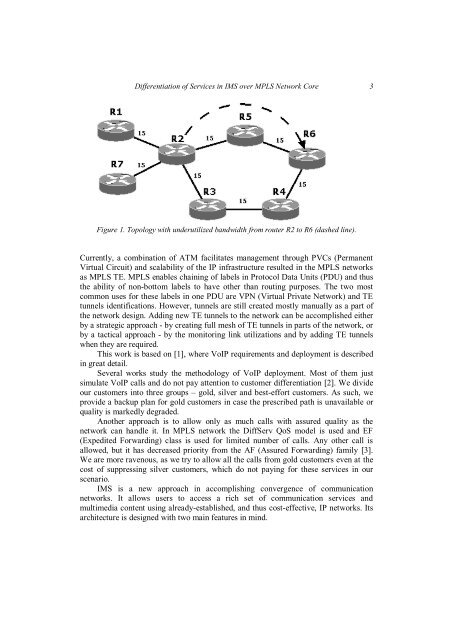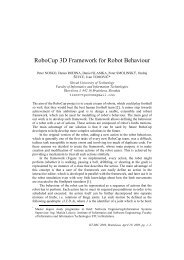Differentiation of Services in IMS over MPLS Network Core
Differentiation of Services in IMS over MPLS Network Core
Differentiation of Services in IMS over MPLS Network Core
Create successful ePaper yourself
Turn your PDF publications into a flip-book with our unique Google optimized e-Paper software.
<strong>Differentiation</strong> <strong>of</strong> <strong>Services</strong> <strong>in</strong> <strong>IMS</strong> <strong>over</strong> <strong>MPLS</strong> <strong>Network</strong> <strong>Core</strong> 3Figure 1. Topology with underutilized bandwidth from router R2 to R6 (dashed l<strong>in</strong>e).Currently, a comb<strong>in</strong>ation <strong>of</strong> ATM facilitates management through PVCs (PermanentVirtual Circuit) and scalability <strong>of</strong> the IP <strong>in</strong>frastructure resulted <strong>in</strong> the <strong>MPLS</strong> networksas <strong>MPLS</strong> TE. <strong>MPLS</strong> enables cha<strong>in</strong><strong>in</strong>g <strong>of</strong> labels <strong>in</strong> Protocol Data Units (PDU) and thusthe ability <strong>of</strong> non-bottom labels to have other than rout<strong>in</strong>g purposes. The two mostcommon uses for these labels <strong>in</strong> one PDU are VPN (Virtual Private <strong>Network</strong>) and TEtunnels identifications. However, tunnels are still created mostly manually as a part <strong>of</strong>the network design. Add<strong>in</strong>g new TE tunnels to the network can be accomplished eitherby a strategic approach - by creat<strong>in</strong>g full mesh <strong>of</strong> TE tunnels <strong>in</strong> parts <strong>of</strong> the network, orby a tactical approach - by the monitor<strong>in</strong>g l<strong>in</strong>k utilizations and by add<strong>in</strong>g TE tunnelswhen they are required.This work is based on [1], where VoIP requirements and deployment is described<strong>in</strong> great detail.Several works study the methodology <strong>of</strong> VoIP deployment. Most <strong>of</strong> them justsimulate VoIP calls and do not pay attention to customer differentiation [2]. We divideour customers <strong>in</strong>to three groups – gold, silver and best-effort customers. As such, weprovide a backup plan for gold customers <strong>in</strong> case the prescribed path is unavailable orquality is markedly degraded.Another approach is to allow only as much calls with assured quality as thenetwork can handle it. In <strong>MPLS</strong> network the DiffServ QoS model is used and EF(Expedited Forward<strong>in</strong>g) class is used for limited number <strong>of</strong> calls. Any other call isallowed, but it has decreased priority from the AF (Assured Forward<strong>in</strong>g) family [3].We are more ravenous, as we try to allow all the calls from gold customers even at thecost <strong>of</strong> suppress<strong>in</strong>g silver customers, which do not pay<strong>in</strong>g for these services <strong>in</strong> ourscenario.<strong>IMS</strong> is a new approach <strong>in</strong> accomplish<strong>in</strong>g convergence <strong>of</strong> communicationnetworks. It allows users to access a rich set <strong>of</strong> communication services andmultimedia content us<strong>in</strong>g already-established, and thus cost-effective, IP networks. Itsarchitecture is designed with two ma<strong>in</strong> features <strong>in</strong> m<strong>in</strong>d.








